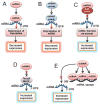Noncoding RNA as therapeutic targets for hepatocellular carcinoma
- PMID: 25632936
- PMCID: PMC4427038
- DOI: 10.1055/s-0034-1397350
Noncoding RNA as therapeutic targets for hepatocellular carcinoma
Abstract
Recent studies have suggested that noncoding RNAs (ncRNAs) contribute to the pathogenesis and progression of hepatocellular carcinoma (HCC). These RNA genes may be involved in various pathobiological processes such as cell proliferation, apoptosis, angiogenesis, invasion, and metastasis. Aberrant expression of ncRNA resulting from deregulated epigenetic, transcriptional, or posttranscriptional activity has been described in several studies. ncRNAs are comprised of a highly diverse group of transcripts that include microRNAs (miRNAs) and long noncoding RNAs (lncRNAs) as well as several other types of RNA genes. Understanding the molecular mechanisms by which ncRNA contribute to hepatocarcinogenesis may enable the design of ncRNA-based therapeutics for HCC. In this review, the authors provide a perspective on therapeutic applications based on the emerging evidence of a contributory role of miRNAs and lncRNAs to the pathogenesis and progression of HCC. In addition, ncRNAs that are deregulated in expression in HCC may have utility as potential prognostic or diagnostic markers.
Thieme Medical Publishers 333 Seventh Avenue, New York, NY 10001, USA.
Figures

References
-
- Chun JM, Kwon HJ, Sohn J, Kim SG, Park JY, Bae HI, Yun YK, Hwang YJ. Prognostic factors after early recurrence in patients who underwent curative resection for hepatocellular carcinoma. J Surg Oncol. 2011;103:148–151. - PubMed
-
- Jemal A, Bray F, Center MM, Ferlay J, Ward E, Forman D. Global cancer statistics. CA Cancer J Clin. 2011;61:69–90. - PubMed
-
- Esteller M. Non-coding RNAs in human disease. Nat Rev Genet. 2011;12:861–874. - PubMed
-
- Mattick JS, Makunin IV. Non-coding RNA. Hum Mol Genet. 2006;15:R17–R29. - PubMed
Publication types
MeSH terms
Substances
Grants and funding
LinkOut - more resources
Full Text Sources
Other Literature Sources
Medical

